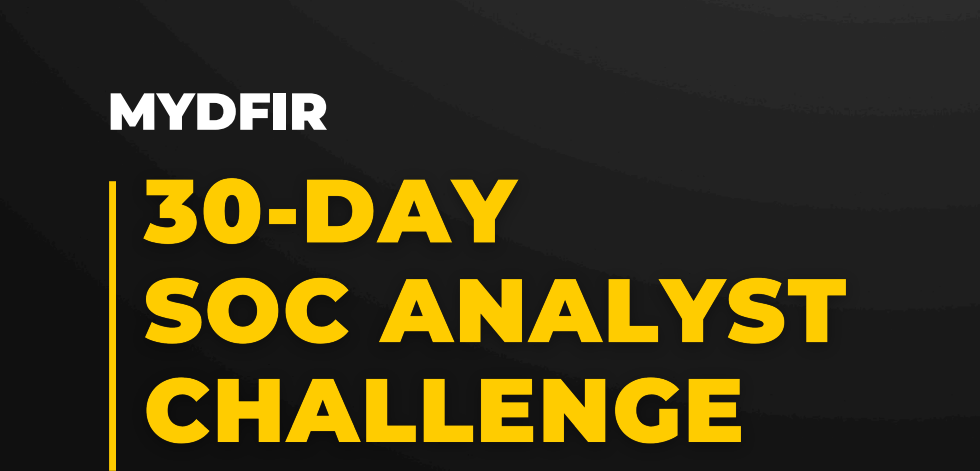Day-30 Completed MYDFIR SOC Analyst 30 Day Challenge!
Day 1: Creating Logical Diagram
- Importance of logical diagrams for visualizing network infrastructure.
- Components: Windows Server (RDP), Fleet Server, Ubuntu Server (SSH), Elastic & Kibana, OS Ticket Server, C2 Server (Mythic), VULTR, VPC, Internet Gateway.
Day 2: ELK Stack Introduction
- Introduction to Elastic (search & analytics), Logstash (data collection), and Kibana (data visualization).
- Explains how these tools work together like a detective team.
- Briefly compares ELK to Splunk.
Day 3: Elasticsearch Setup
- Setting up Elasticsearch on a Vultr cloud instance.
- Covers installation, configuration, and service management.
Day 4: Kibana Setup
- Setting up Kibana on the same Vultr instance as Elasticsearch.
- Covers installation, configuration, access with enrollment token, and verification code.
Day 5: Windows Server 2022 Installation
- Creates a Windows server as a target machine for simulated attacks.
- Explains deployment on Vultr, access with RDP, and exposing RDP to the internet.
Day 6: Elastic Agent and Fleet Server Introduction
- Explains the role of Elastic Agent (universal data shipper) and Fleet Server (centralized management).
- Discusses benefits like centralized control, scalability, and improved visibility.
- Compares Elastic Agent to Beats modules.
Day 7: Elastic Agent and Fleet Server Setup
- Setting up Fleet Server on Vultr and integrating it with Elastic Agent.
- Covers server creation, policy generation, firewall configuration, and enrollment.
- Touches on troubleshooting common errors during enrollment.
Day 8: What is Sysmon?
- Explains Sysmon as a Windows tool for advanced event logging.
- Details the benefits of Sysmon compared to default Windows event logs.
- Covers Sysmon functionalities like process creation, network connections, and file changes.
Day 9: Sysmon Setup
- Setting up Sysmon on the target Windows server.
- Covers downloading, configuration, installation using PowerShell, and verification.
Day 10: Elasticsearch Ingest Data Tutorial
- Integrating Sysmon and Windows Defender logs with Elasticsearch.
- Explains adding integrations for each log source using the channel name and specific event IDs.
- Covers troubleshooting steps if data is not ingested properly.
Day 11: Brute Force Attacks
- Hackers use trial-and-error to guess passwords, encryption keys, or other sensitive data.
- Methods include simple brute force attacks and dictionary attacks.
- Consequences include data theft, identity theft, financial loss, and reputation damage.
Day 12: Ubuntu Server Installation
- You installed Ubuntu Server 24.04 and SSH.
- You used the
catandgrepcommands to examine authentication logs. - These logs revealed a classic example of a brute force attack.
Day 13 & 14: Elastic Agent and Kibana
- You installed the Elastic Agent on your Ubuntu server.
- You used Kibana to explore and analyze authentication logs.
- You created alerts and dashboards to monitor for suspicious activity.
Day 15: Remote Desktop Protocol
- RDP allows remote access to computers but can be a security vulnerability.
- Attackers can use brute force attacks, credential stuffing, and other methods to exploit RDP.
- You learned methods to protect your RDP endpoints from attacks.
Day 16: Creating Rules and Alerts in Kibana
- You created alerts for failed Windows authentication attempts.
- You created rules to detect unusual login patterns for SSH and RDP.
Day 17: Creating Dashboards and Visualizations
- You built dashboards to visualize RDP successful and failed authentication attempts.
- You created visualizations for both SSH and RDP failed and successful authentication attempts.
Day 18: Command and Control Introduction
- Malicious links can lead to command-and-control (C2) servers.
- C2 servers allow attackers to maintain control over compromised systems.
- Popular C2 tools include Metasploit, Empire, Cobalt Strike, PowerSploit, and Mythic.
Day 19: Creating Attack Diagram
- Importance of understanding attacker strategy (“know your enemy”)
- Planning an attack helps fortify defenses (ethical hacking)
- Introduction to MITRE ATT&CK framework and Cyber Kill Chain
Day 20: Mythic Server Setup
- Building a Mythic C2 server on Vultr cloud using Ubuntu
- Installation process using Docker commands
- Accessing the Mythic dashboard
Day 21: Mythic Agent Setup
- Setting up a brute force RDP attack on a Windows server
- Using Kali Linux with tools like Crowbar
- Creating a C2 agent on the Windows server using Mythic-CLI
- Downloading and executing the payload
Day 22: Dashboard and Alerts for Mythic C2
- Creating alerts for process creation, initialization, and Windows Defender disable
- Building a dashboard with visualizations for different event codes
Day 23: Ticketing System
- Introduction to ticketing systems (help desk, issue tracking)
- Benefits of using a ticketing system (organization, efficiency, communication)
- Key features of OSticket (open-source ticketing tool)
Day 24: osTicket Setup
- We deployed a new Windows Server instance for osTicket.
- We installed XAMPP (Apache, MySQL, PHP) on the server.
- We configured XAMPP and the database for osTicket.
- We downloaded and installed osTicket.
- We configured the osTicket installer and created an admin account.
Day 25: osTicket and ELK Integration
- We logged into the osTicket admin panel.
- We created a new API key in osTicket with the private IP address of the ELK instance.
- We logged into the Elastic GUI.
- We attempted to access the “Create Connector” option, but it requires a paid license.
Day 26 & 27: Investigate SSH and RDP Brute-Force Attack
- Configured OSticket to generate alerts for SSH/RDP brute-force attacks.
- Simulated attacks and investigated alerts in OSticket.
Day 28: Investigate Mythic Agent
- Analyzed Mythic Agent activity in Elastic.
- Identified suspicious activity and traced execution flow.
- Created a rule to detect Mythic Agent activity.
Day 29: Elastic Defend
- Set up Elastic Defend for EDR.
- Tested EDR functionality by attempting a malicious download.
- Observed successful prevention and alert generation.
- Analyzed alert details and configured a response action.
